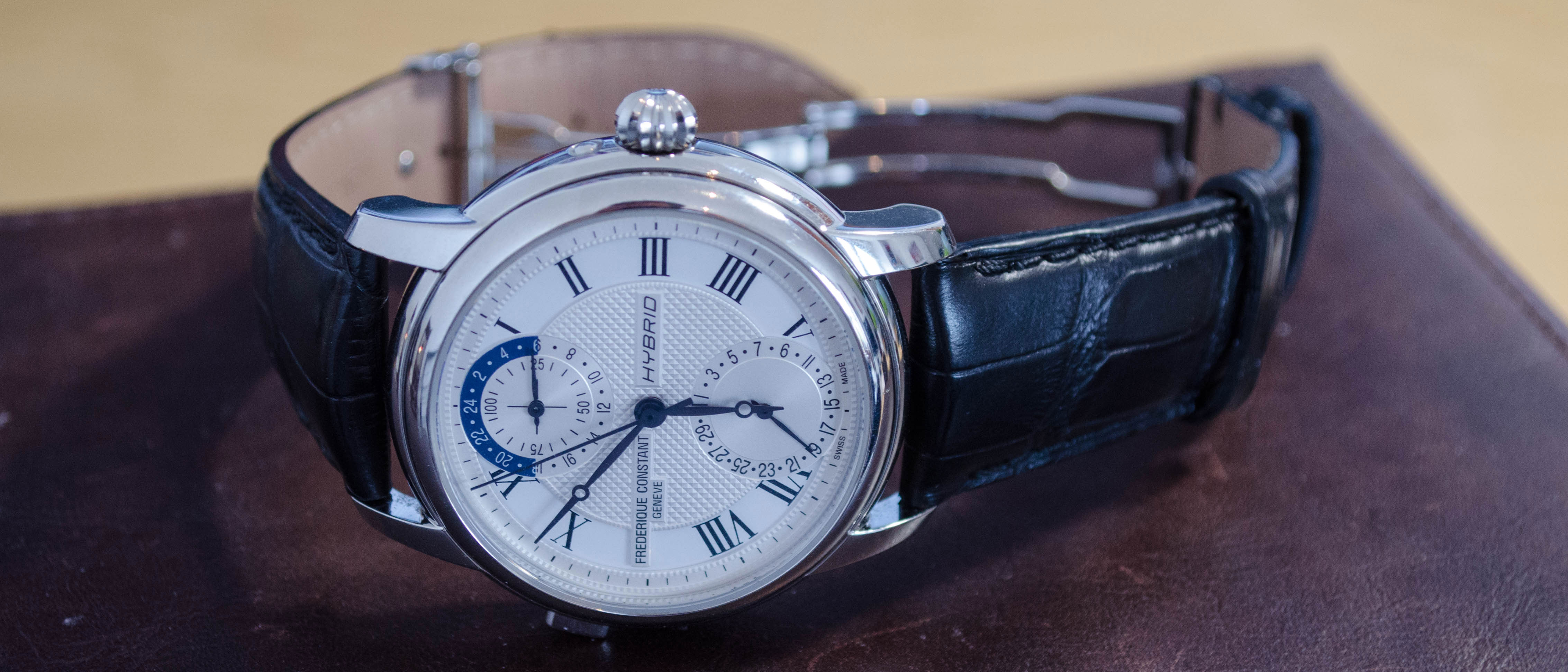Why you can trust TechRadar
Specs, features and performance
- FC-750 movement with 33 jewels and 42-hour power reserve
- Smart features have seven-day battery life
- iOS and Android app offers activity and sleep tracking, plus watch performance data
As we alluded to earlier, the digital and analogue sides of the Frederique Constant Hybrid Manufacture should be considered as two separate pieces of technology. They do not power each other and do not rely on each other to function.
However, if you open the companion app (available for iOS and Android), there is one area where digital and analogue worlds collide. For the watch geeks among you, the app can be used to check up on the watch’s mechanical performance.
Specifically, you can check the rate (how fast or slow the watch is running each day), the amplitude (the amount of rotation in the swing of the balance wheel, a good indication of overall health), and the beat error (how equal each swing of the balance wheel oscillation is).

If your eyes have glazed over at this point, then fear not - this is only one page of the app, each measurement is explained in layman's terms, and this data can be used to alert you if the watch needs maintenance or a service.
A quick note on reliability: During our week with the watch, the smart dial twice got itself out of sync, forgetting where 12 o’clock was and instead resetting randomly to a different position. This then made all three of its readouts wrong, forcing us to reset its position - something the app allows you to do, suggesting Frederique Constant knows it can sometimes go haywire.
Fitness
- Very limited abilities, with no heart rate monitor, GPS or other smartwatch features
- Sleep and exercise tracking require manual control - only regular steps are counted automatically
The rest of the app will be more familiar to smartwatch and hybrid watch owners. Sleep and activity are displayed as rings to be filled (just like on the Apple Watch), and there is a Coach section which offers advice based on what you get up to. We thought this would be fairly generic, but the pointers it provides closely relate to how lazy or active we have been. Improvements in daily steps are congratulated, while a lack of activity compared to previous days is brought up with advice for improving.
The Hybrid Manufacture’s ability to track steps and sleep felt fairly accurate, but the data produced by the app is quite basic, and there are some disappointing shortfalls. For example, you have to open the app then press the watch’s 10 o’clock button before it will sync with your phone; other hybrid and smart watches do this automatically, so pressing the button every time we wanted to check the data or adjust a setting felt like a step backwards.

Also, the watch does not automatically start sleep tracking. Instead, you can start it with a long press of the button, or by digging into the app and starting it manually. Sleep tracking then needs to be stopped manually when you wake up, or there is a function which stops tracking after you have completed 250 steps.
Presumably this is to prevent it getting confused if you get up briefly in the night, but we have to wonder who can log 250 steps popping to the bathroom and back. Perhaps the owner of a £3,000 watch, but we digress...

On the plus side, you can opt to track sleep either by wearing the watch, or by placing it on your bed. The latter produces less accurate measurements, but it works nonetheless if that’s what you want.
Although the step- and sleep-tracking works relatively well, we seriously doubt many people will use a £3,000 smartwatch for logging exercise or anything more strenuous than a day of wondering around the Monaco Yacht Show.
Battery life
- Mechanical side is powered by movement or the included rotating case
- Smart side is powered by the case or USB cable and lasts about six days
- Detachable charger is inexcusable ugly
Hybrid smartwatches outshine their touchscreen relatives when it comes to battery life, and the Frederique Constant is no exception. The mechanical side will last for as long as it is worn, then keeps time for 42 hours after you take it off before the mechanism needs powering back up (done by movement, or the included rotating case).
The battery-powered smart side of the watch is claimed to last “seven plus” days, although we found it had run dry at the start of our seventh day of use. Charging up is done by placing it in the case, or by attaching the inner mount to a mini USB cable. There appears to be no app notification to say the battery is running low, as we only discovered it was almost flat when syncing with the app and viewing the percentage there.

A quick note on the charging case, which is huge, wooden, and looks a bit like a flipper from Robot Wars when open. It is certainly what Swiss watch buyers will expect, and likely admire, but the detachable plastic mount is ugly and feels incredibly cheap.
The ‘designed in Geneva, made in China’ stamp of apparent approval doesn’t help its cause, and when attached to a USB cable (for when you are traveling and leave the main case at home), there’s no real way to sit it down neatly. Mostly, the watch just tumbles over onto its face.
Current page: Specs, fitness and battery life
Prev Page Introduction, price and design Next Page VerdictAlistair Charlton is based in London and has worked as a freelance technology and automotive journalist for over a decade. A lifelong tech enthusiast, Alistair has written extensively about dash cams and robotic vacuum cleaners for TechRadar, among other products. As well as TechRadar, he also writes for Wired, T3, Forbes, The Independent, Digital Camera World and Grand Designs Magazine, among others.

